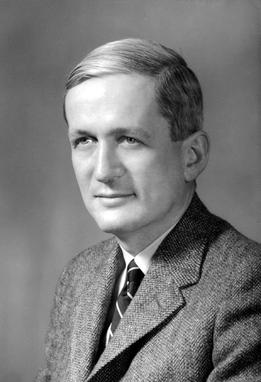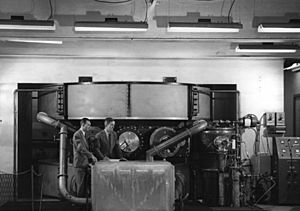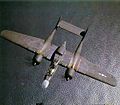Norman Foster Ramsey Jr. facts for kids
Quick facts for kids
Norman Foster Ramsey Jr.
|
|
|---|---|
 |
|
| Born | August 27, 1915 Washington, D.C., U.S.
|
| Died | November 4, 2011 (aged 96) Wayland, Massachusetts, U.S.
|
| Alma mater | |
| Known for | Ramsey interferometry |
| Relatives | Anne Ramsey (cousin) |
| Awards |
|
| Scientific career | |
| Fields | Physics |
| Institutions | |
| Doctoral advisor | Isidor Isaac Rabi |
| Doctoral students |
|
| Other notable students | Sunney Chan (post doc) |
Norman Foster Ramsey Jr. (born August 27, 1915 – died November 4, 2011) was an American scientist who studied physics. He won the Nobel Prize in Physics in 1989. He earned this award for inventing a special method that helped create very accurate atomic clocks.
Ramsey was a physics professor at Harvard University for most of his career. He also worked with important government and international groups like NATO. He helped start major science centers such as Brookhaven National Laboratory and Fermilab.
Contents
Early Life and Education
Norman Foster Ramsey Jr. was born in Washington, D.C. on August 27, 1915. His mother, Minna Bauer Ramsey, taught at the University of Kansas. His father, Norman Foster Ramsey, was an officer in the U.S. Army. He became a brigadier general during World War II.
Because his father was in the Army, Norman moved often. He even lived in France for a while. This meant he skipped some grades in school. He finished Leavenworth High School in Kansas when he was just 15.
College Years and Early Physics Discoveries
Ramsey's parents wanted him to go to the military academy. But he was too young to join at 15. So, in 1931, he started studying engineering at Columbia University. He soon became very interested in mathematics and then in physics.
After getting his first degree from Columbia in 1935, he went to Cambridge University in England. There, he studied physics at the Cavendish Laboratory. He learned about quantum mechanics, a new and exciting area of physics.
While at Cambridge, Ramsey became interested in molecular beams. He decided to return to Columbia University to work with Isidor Isaac Rabi. Rabi later won the Nobel Prize for inventing a way to study atoms using molecular beams. Ramsey was part of Rabi's team. They worked together on early experiments using this new method. They discovered that the deuteron (a type of atomic nucleus) was not perfectly round, which was a big surprise.
Ramsey earned his PhD in physics from Columbia in 1940. He then became a fellow at the Carnegie Institution for Science in Washington, D.C. There, he studied how tiny particles like neutrons and protons interact.
World War II Contributions
In 1940, Norman Ramsey married Elinor Jameson. He also started teaching at the University of Illinois at Urbana-Champaign. But World War II changed their plans.
Developing Radar Technology
In 1940, British scientists shared a new invention with the U.S. called the cavity magnetron. This device was key to making powerful radar systems. Ramsey was asked to join the Radiation Laboratory at the Massachusetts Institute of Technology (MIT) to work on this.
Ramsey's team worked to make radar waves shorter and more effective. Shorter waves meant radar could be smaller, lighter, and better. He even traveled to Britain to share ideas with other scientists. The new radar technology was so important that a special night fighter plane, the Northrop P-61 Black Widow, was designed around it.
Working on the Manhattan Project
In 1943, Ramsey was asked to join the Manhattan Project. This was a secret project to build the first nuclear weapons. He became a leader in the Ordnance Division at the Los Alamos Laboratory. His job was to make sure the nuclear weapons were designed correctly and could be delivered by aircraft.

Ramsey had to figure out which airplanes could carry the bombs. Only two planes were big enough: the British Avro 683 Lancaster and the American Boeing B-29 Superfortress. The U.S. Army Air Forces wanted to use the B-29. Ramsey oversaw many test drops of dummy bombs. These tests helped fix problems with the bombs and the planes.
Ramsey also helped plan how the weapons would be used in combat. He went to Tinian island with the team that would assemble the bombs. He was involved in putting together the Fat Man bomb, which was later dropped on Nagasaki.
Post-War Research and Discoveries
After the war, Ramsey went back to Columbia University as a professor. He continued his work on molecular beam experiments. He and his student, William Nierenberg, measured important properties of atoms and molecules. Ramsey also helped create the Brookhaven National Laboratory on Long Island.
In 1947, he moved to Harvard University, where he taught for 40 years. He also advised NATO on science, helping to train European scientists.
The Separated Oscillatory Field Method
Ramsey wanted to make very accurate measurements of atoms and molecules. He found it hard to create perfectly steady magnetic fields, which were needed for accuracy. So, in 1949, he invented the "separated oscillatory field method." This new method allowed for much more precise measurements.
Ramsey and his student, Daniel Kleppner, also developed the atomic hydrogen maser. A maser is like a laser, but it uses microwaves instead of light. This invention helped them measure the tiny energy differences within atoms more accurately.
His work was crucial for creating super-accurate atomic clocks. Since 1967, the definition of a "second" has been based on the vibrations of a cesium-133 atom. The atomic clocks that keep this standard use Ramsey's ideas. For his invention of the separated oscillatory field method and its use in atomic clocks, he won the Nobel Prize in Physics in 1989. He shared the prize with Hans Georg Dehmelt and Wolfgang Paul.
Ramsey also worked on applying his methods to beams of neutrons. He measured the neutron's magnetic properties. As President of the Universities Research Association in the 1960s, he helped design and build Fermilab, a major particle physics laboratory in Illinois.
Later Life and Awards
Ramsey became a highly respected physics professor at Harvard and retired in 1986. However, he continued to be active in physics research. He visited and taught at several other universities.
Besides the Nobel Prize, Ramsey received many other awards. These include the National Medal of Science in 1988 and the IEEE Medal of Honor in 1984. He was also a member of important scientific groups like the United States National Academy of Sciences.
His first wife, Elinor, passed away in 1983. He later married Ellie Welch. Norman Foster Ramsey Jr. died on November 4, 2011. He was remembered for his groundbreaking work that helped us understand the universe better and create technologies like atomic clocks.
Images for kids
-
The Northrop P-61 Black Widow night fighter was designed to use new radar.
See also
 In Spanish: Norman Foster Ramsey para niños
In Spanish: Norman Foster Ramsey para niños



